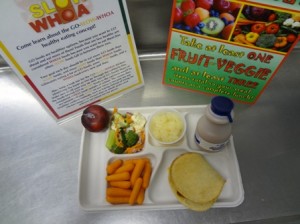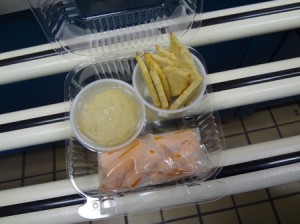A Behind the Scenes Look at the New School Nutrition Rules
When school started this year, our kids were welcomed with healthier fare in the cafeteria. The new school nutrition guidelines kicked in, which meant less fat, sugar and salt, and more fruits, vegetables, whole grains and low-fat dairy. It all sounds great, right? However, there has been some criticism in the past few months that kids aren’t getting enough to eat. As a mom, I wanted to see for myself what the new food trays look like so I did a little investigative work and I’ve got lots of information to report back to you–thankfully, it’s all good news!
I reached out to the head dietitian at the Red Clay School District (my local district), Jessica Terranova, and explained to her some of the comments and concerns I’ve been hearing. I asked her if I could meet with her and visit my local K-8 school (Brandywine Springs) to see for myself what the meals looked like and if there was any truth to this perception that our children were being underfed with the new guidelines. Jessica was more than happy to have me come visit as she had heard some of the complaints herself and was eager to set the record straight on all the great work the district had been doing with the new guidelines.

Not only was I satisfied when Jessica took me to the school’s cafeteria and began showing me the choices the children had, I was impressed! They were able to choose from a hot lunch, which is the traditional lunch tray line and then the cold lunch, which looked more like an a la carte lunch. The hot lunch line that day consisted of a whole grain taco/quesadilla with beef and cheese, their choice between diced pears or applesauce, a marinated veggie salad and baby carrots and, if they wanted they could choose either a fresh plum or a small dish of fresh red grapes and sliced orange sections. Fat free milk of their flavor choice (plain, chocolate or strawberry) completed the meal. This is a good amount of food for children 5-12 years of age! The calorie guidelines for that age group are 550-650 calories while the guidelines for the high school age group are 850. If the children selected the cold lunch line they had options like a chef salad, various sandwiches on whole grain bread, low-fat yogurt parfaits with fruit and even a hummus platter with veggies and whole grain pita chips. All the snacks that were available were of the baked variety and only water, fat-free milk and 100% juice were the beverages options.

I walked through the lunch room to see if the children were eating their meals and for the most part I’m happy to report they were. One thing I was surprised to find was how many of the kids opted for salad–girls AND boys! Jessica tells me that since the new guidelines have gone into effect, they have seen an increase in their consumption of fruit. For example, last year they would go through one case of apple sauce per week, they’re now doubling that. I asked how the guidelines have changed the look of the plate and she tells me not much–basically they’ve had to cut down on the amount of meat or cheese they would put into the taco, but now they require the children to take a fruit and veggie, where before some of the kids might walk away from the line with only a taco on their trays. As it turns out, in these cases the kids are actually taking MORE food than they had in the past. The reality is not that the kids aren’t getting enough to eat, it’s are they getting what they necessarily want or are used to eating? In fact, a visual the district has provided for parents shows how 850 calories of fast food compares with 850 calories of nutritious lunches the schools are providing. Jessica says that in the younger grades there is much less resistance than the older grades, which supports the idea that the younger you start children with healthy eating, the better!
A few tips Jessica and Red Clay have used is to cut some whole fruit (like oranges) up for younger grades to make it easer to eat and encourage athletes who require more calories to bring healthy snacks with them for later in the day before practice. I hope this has helped to shine some light on the confusion around these new guidelines. My advice to parents would be to contact your own school nutritionist or food service manager and see if they are also doing some of these things to help with the transition to the new guidelines. Get involved and share some of these tips with them as it will only benefit your own kids. You can get even more info from the USDA website.
See all posts


